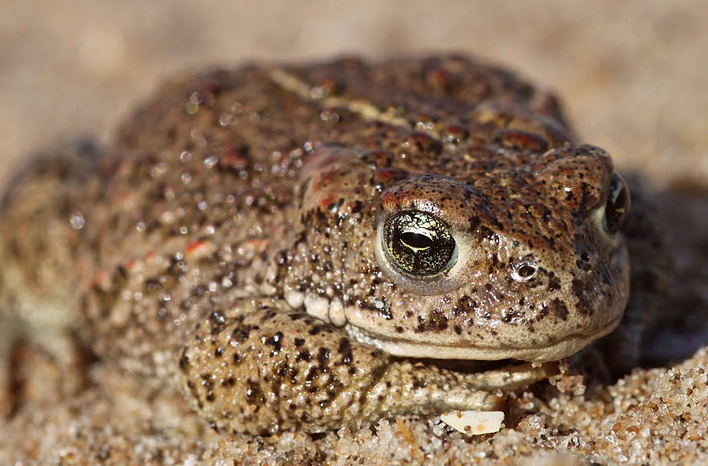
Natterjack toads – rare native to National Parks
11 July 2018
Just two populations of this rare and elusive species are left in the New Forest National Park. Dr. Laurence Jarvis Science and Research Manager at Froglife takes a close look at this unusual toad as part of our #summerofbeauty
On a chilly spring night along the north Cumbrian coast an unusual sound may be heard, “chirrup…..chirrup”, quiet at first, but rising to a cacophony of chorus. What is this curious sound? It’s the sound of many natterjack toads, calling to attract females. Males have large vocal sacs which amplify the sound, which may be heard from over a kilometre away.
What is a natterjack toad?
The natterjack toad (Epidalea calamita) is the rarest of the UK’s native breeding amphibian species. It is related to common toads, but unlike their relatives, the natterjack toad lives mainly in sandy soils, particularly lowland heath and coastal sand dunes. Adults are highly secretive, spending much of the year burrowed deep inside sand dunes or within heathland. The adults can move very quickly and run compared to the rather slow hops of the common toad.
breeding amphibian species. It is related to common toads, but unlike their relatives, the natterjack toad lives mainly in sandy soils, particularly lowland heath and coastal sand dunes. Adults are highly secretive, spending much of the year burrowed deep inside sand dunes or within heathland. The adults can move very quickly and run compared to the rather slow hops of the common toad.
Natterjack toad. Photo credit: Matt Wilson.
In which National Parks can natterjack toads be found?
Natterjack toads only occur at approximately 60 locations across the UK w ith the majority occurring on the northwest coast of Cumbria. The only National Park which supports breeding populations of natterjack toad is the New Forest. Here only two populations can now be found on the open heathland areas where shallow ponds occur.
ith the majority occurring on the northwest coast of Cumbria. The only National Park which supports breeding populations of natterjack toad is the New Forest. Here only two populations can now be found on the open heathland areas where shallow ponds occur.
When is the best time of year to find a natterjack toad?
The best time of year to find a natterjack toad is during the breeding season, which extends from April to July. Males congregate at ponds and call loudly for females from dusk until midnight. Visit a breeding pond at dusk on a mild evening during the spring with a torch.
Males may be found hiding in vegetation close to ponds, or calling from within the water. The males can be quite bold, although if you disturb calling males, they soon quieten down and become more secretive. Males tend to arrive at breeding ponds before females, with the oldest individuals arriving first and the younger ones arriving later. Their call is further enhanced by a large vocal sac which helps resonate and amplify the sound and this gives them the loudest call of the UK’s native amphibians. Females only spend a very short time at ponds (sometimes only 24 hours), before leaving.
Typical sand dune habitats favoured by natterjack toads. Photo credit: Matt Wilson
Where do natterjack toads go when they are not breeding?
Like many amphibian species, natterjack toads rely heavily on the presence of suitable habitat to survive and connectivity between habitats is crucial for the persistence of populations. After metamorphosing from tadpoles, the young juveniles disperse into terrestrial habitats to feed and grow. They may disperse widely and travel up to 3 km in search of breeding ponds.
Both adults and juveniles will hide during daylight hours, occurring in sand dunes, small mammal burrows, cracks in stone walls and within dense vegetation. At night adult natterjack toads may roam more widely in search of food and juveniles may seek out a potential breeding pond.
Once established at a breeding site, male natterjack toads are highly site faithful, with 90% of individuals returning to the same pond each year to breed. However, females are more mobile and will travel to different ponds each year to lay their eggs. This promotes movement and mixing of genes between populations.
Why are natterjack toads threatened?
Natterjack toad populations are threatened in the UK from a range of factors including isolation, introduced disease and climate change.
Isolation is a big threat as the majority of natterjack toad populations are currently not within the range of other breeding ponds.
In addition, the fungal infection which causes chytridiomycosis has been found in natterjack toad populations. Globally, this disease has caused devastating impacts, causing mortality and spreading through large numbers of amphibian species, particularly in tropical regions. In the UK, however, the disease has not yet spread, but biosecurity (e.g. cleaning boots and equipment) when near to natterjack toad populations is crucial to avoid transmitting the disease to other amphibians.
Climate change too may impact on this species as unpredictable levels of rainfall and an increase in dry weather during the spring and summer may cause ponds to desiccate more quickly and result in fewer tadpoles being able to metamorphose.
By Dr Laurence Jarvis,
Science and Research Manager at Froglife
For more information on the work of froglife to conserve amphibians an reptiles click here.

